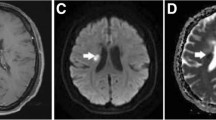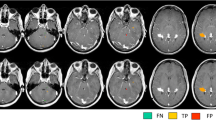Abstract
Objectives
We aimed at establishing the impact upon gadolinium administration on the conspicuity of active enhancing multiple sclerosis (MS) lesions using double inversion recovery (DIR) at 3T.
Methods
15 consecutive patients with MS (n=8) or a clinically isolated syndrome (n=7) underwent pre and post-contrast DIR in addition to T2-weighted, FLAIR, pre and post-contrast T1-weighted sequences. First, two neuroradiologists located and marked all the enhancing MS lesions visible in consensus. Second, two other neuroradiologists, blinded to other sequences than DIR, independently assessed the SI changes from pre to post-contrast DIR images for each enhancing lesion, according to a 4-point-scale: increased SI (grade 1), absence of change (grade 2), lesion being partially (grade 3) or completely masked on post-contrast DIR images (grade 4).
Results
246 MS lesions were detected including 26 enhancing on post-contrast T1-weighted images in 9 patients. The two blinded readers concluded to a decreased signal-intensity on post-contrast DIR images for all the 26 enhancing MS lesions (14 of grade 3 and 12 of grade 4). Inter-observer agreement was excellent, Kappa=0.85 (0.75 - 0.94). Using DIR post-contrast leads to altered signal-intensity of enhancing active MS lesions, ranging from partial to complete signal-loss.
Conclusion
Our study strongly suggests the use of DIR before gadolinium administration.
Key Points
• DIR has gained widespread use in MS.
• MRI protocols for MS patients usually contain several post-contrast sequences.
• Signal-intensity of enhancing MS lesions is altered using DIR post-contrast.
• Our study strongly suggests the use of DIR before gadolinium administration.

Similar content being viewed by others
Abbreviations
- MS:
-
Multiple sclerosis
- RRMS:
-
Relapsing remitting multiple sclerosis
- CIS:
-
Clinically isolated syndrome
- DIS:
-
Dissemination of brain lesions in space
- DIT:
-
Dissemination of brain lesions in time
- SI:
-
Signal-intensity
- DIR:
-
Double inversion recovery
- FLAIR:
-
Fluid-attenuated inversion recovery
References
Polman CH, Reingold SC, Banwell B et al (2011) Diagnostic criteria for multiple sclerosis: 2010 revisions to the McDonald criteria. Ann Neurol 69(2):292–302
Uysal E, Erturk SM, Yildirim H et al (2007) Sensitivity of immediate and delayed gadolinium-enhanced MRI after injection of 0.5 M and 1.0 M gadolinium chelates for detecting multiple sclerosis lesions. AJR. Am J Roentgenol 188(3):697–702
Calabrese M, De Stefano N, Atzori M et al (2007) Detection of cortical inflammatory lesions by double inversion recovery magnetic resonance imaging in patients with multiple sclerosis. Arch Neurol 64(10):1416–1422
Geurts JJ, Bo L, Pouwels PJ et al (2005) Cortical lesions in multiple sclerosis: combined postmortem MR imaging and histopathology. AJNR Am J Neuroradiol 26(3):572–577
Geurts JJ, Pouwels PJ, Uitdehaag BM et al (2005) Intracortical lesions in multiple sclerosis: improved detection with 3D double inversion-recovery MR imaging. Radiology 236(1):254–260
Seewann A, Kooi EJ, Roosendaal SD et al (2012) Postmortem verification of MS cortical lesion detection with 3D DIR. Neurology 78(5):302–308
Simon B, Schmidt S, Lukas C et al (2010) Improved in vivo detection of cortical lesions in multiple sclerosis using double inversion recovery MR imaging at 3 Tesla. Eur Radiol 20(7):1675–1683
Wattjes MP, Lutterbey GG, Gieseke J et al (2007) Double inversion recovery brain imaging at 3T: diagnostic value in the detection of multiple sclerosis lesions. AJNR Am J Neuroradiol 28(1):54–59
Riederer I, Karampinos DC, Settles M et al (2015) Double inversion recovery sequence of the cervical spinal cord in multiple sclerosis and related inflammatory diseases. AJNR Am J Neuroradiol 36(1):219–225
Hodel J, Outteryck O, Bocher AL et al (2014) Comparison of 3D double inversion recovery and 2D STIR FLAIR MR sequences for the imaging of optic neuritis: pilot study. Eur Radiol 24(12):3069–3075
Krinsky G, Rofsky NM, Weinreb JC (1996) Nonspecificity of short inversion time inversion recovery (STIR) as a technique of fat suppression: pitfalls in image interpretation. AJR Am J Roentgenol 166(3):523–526
Mathews VP, Caldemeyer KS, Lowe MJ et al (1999) Brain: gadolinium-enhanced fast fluid-attenuated inversion-recovery MR imaging. Radiology 211(1):257–263
Harris RJ, Cloughesy TF, Pope WB et al (2013) Pre- and post-contrast three-dimensional double inversion-recovery MRI in human glioblastoma. J Neuro-Oncol 112(2):257–266
Acknowledgments
The scientific guarantor of this publication is Prof Xavier Leclerc. David Chechin is an employee of Philips. All the other authors of this manuscript declare no relationships with any companies, whose products or services may be related to the subject matter of the article. The authors state that this work has not received any funding. One of the authors has significant statistical expertise: Mr Mohamed Amine Benadjaoud kindly provided statistical advice for this manuscript. No complex statistical methods were necessary for this paper. Our institutional review board waived the requirement to obtain a signed informed consent from the subjects included since the present imaging protocol was similar to that used in clinical routine and did not require any additional gadolinium injection.
Our institutional review board waived the requirement to obtain a signed informed consent from the subjects included because the additional acquisition time related to the post-contrast DIR sequence remained limited. No study subjects or cohorts have been previously reported. Methodology: prospective, observational, performed at one institution.
Author information
Authors and Affiliations
Corresponding author
Rights and permissions
About this article
Cite this article
Hodel, J., Badr, S., Outteryck, O. et al. Altered signal intensity of active enhancing inflammatory lesions using post-contrast double inversion recovery MR sequence. Eur Radiol 27, 637–641 (2017). https://doi.org/10.1007/s00330-016-4416-1
Received:
Revised:
Accepted:
Published:
Issue Date:
DOI: https://doi.org/10.1007/s00330-016-4416-1




